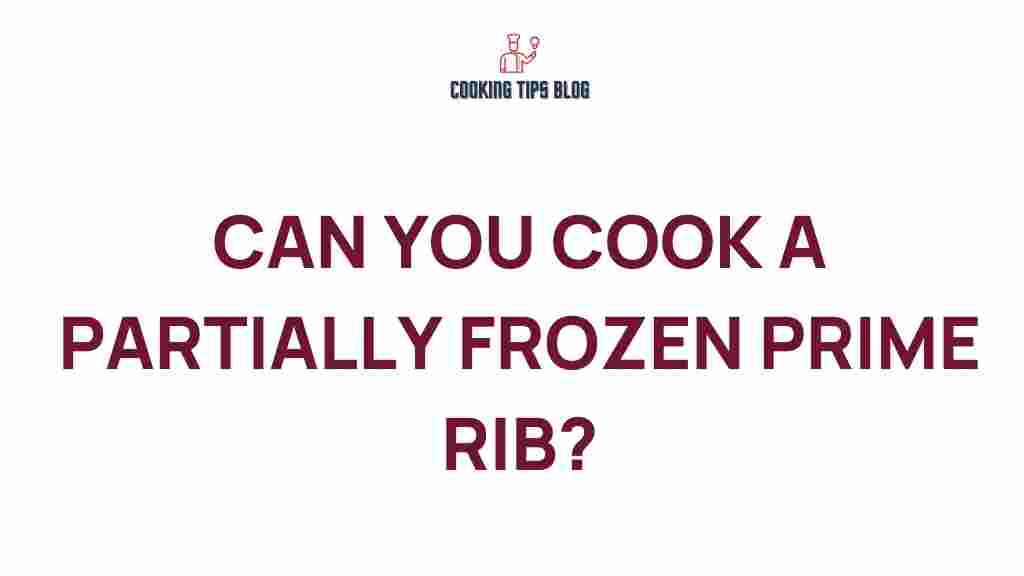Mastering the Art: Can You Cook a Partially Frozen Prime Rib?
Cooking a prime rib is an art that many home chefs aspire to master. This delectable cut of beef is often the centerpiece of holiday dinners and special occasions. However, sometimes we find ourselves in a bind, perhaps forgetting to thaw our prime rib in advance. The question arises: can you cook a partially frozen prime rib? In this article, we’ll explore the nuances of cooking prime rib from a frozen state, provide step-by-step instructions, troubleshooting tips, and ensure your prime rib turns out perfectly tender and delicious.
Understanding Prime Rib
Before diving into the cooking process, it’s essential to understand what prime rib is. Prime rib, also known as standing rib roast, comes from the primal rib section of the cow. It is renowned for its rich flavor and tenderness, making it a favorite among meat lovers. When cooked correctly, it yields juicy slices that are perfect for any occasion.
The Ideal Cooking Temperature for Prime Rib
To achieve the perfect prime rib, one must consider the cooking temperature. The USDA recommends cooking beef to a minimum internal temperature of 145°F (63°C) for safety. However, many chefs prefer to aim for the following internal temperatures for different levels of doneness:
- Rare: 120-125°F (49-52°C)
- Medium Rare: 130-135°F (54-57°C)
- Medium: 140-145°F (60-63°C)
- Medium Well: 150-155°F (65-68°C)
- Well Done: 160°F and above (71°C and above)
When cooking a partially frozen prime rib, it is crucial to adjust these temperatures accordingly to ensure even cooking throughout the meat.
Cooking a Partially Frozen Prime Rib: Step-by-Step Process
Cooking a prime rib from a partially frozen state may seem daunting, but with the right approach, it can be done successfully. Follow these steps to ensure you achieve a delicious outcome:
Step 1: Preparation
Gather your ingredients and tools:
- Partially frozen prime rib
- Salt and pepper
- Garlic powder
- Onion powder
- Olive oil
- Meat thermometer
- Roasting pan
- Aluminum foil
Remove the prime rib from the freezer and let it sit at room temperature for about 30 minutes. This will help it thaw slightly, making it easier to season.
Step 2: Seasoning
Once your prime rib has had some time to thaw, generously season all sides with salt, pepper, garlic powder, and onion powder. Don’t be shy with the seasoning, as it helps to enhance the flavor of the meat.
Step 3: Preheating the Oven
Preheat your oven to 225°F (107°C). Cooking at a lower temperature allows for more even cooking, especially when starting with a partially frozen piece of meat. This method helps to ensure that the outside does not overcook while the inside remains undercooked.
Step 4: Roasting the Prime Rib
Place the seasoned prime rib in a roasting pan, bone-side down. Insert a meat thermometer into the thickest part of the roast, avoiding contact with the bone. This will help you monitor the internal temperature accurately.
Roast the prime rib at 225°F until it reaches an internal temperature of about 10-15°F below your desired final temperature. This could take anywhere from 2 to 4 hours, depending on the size of your roast. A partially frozen prime rib will take longer to cook, so be patient!
Step 5: Searing for a Crust
Once your prime rib is close to the desired internal temperature, it’s time to create a beautiful crust. Increase the oven temperature to 500°F (260°C) and continue roasting for an additional 15-20 minutes. This high heat will give your prime rib a deliciously browned and crispy exterior.
Step 6: Resting the Meat
After achieving your target internal temperature, remove the prime rib from the oven and let it rest for at least 20-30 minutes. Cover it loosely with aluminum foil to keep it warm. Resting allows the juices to redistribute, ensuring every slice is moist and tender.
Troubleshooting Tips for Cooking Prime Rib
Even the best cooks encounter challenges when preparing prime rib. Here are some common issues and how to address them:
Problem: Uneven Cooking
If you notice that your prime rib is cooking unevenly, it may be due to the shape of the roast or the way it was positioned in the oven. Consider the following solutions:
- Use a roasting rack to elevate the meat, allowing for better air circulation.
- Rotate the roasting pan halfway through cooking to ensure even heat distribution.
Problem: Overcooked Exterior, Undercooked Interior
This issue is common when cooking a frozen or partially frozen roast. To avoid this:
- Always use a meat thermometer to monitor internal temperatures.
- Consider starting at a lower oven temperature and gradually increasing it.
Problem: Lack of Flavor
If your prime rib lacks flavor, don’t skip the seasoning step. Here are some additional tips:
- Marinate the prime rib overnight for enhanced flavor.
- Use a dry rub containing herbs and spices for added depth.
Conclusion
Cooking a partially frozen prime rib is entirely feasible with the right approach and techniques. By following the step-by-step process outlined in this article, you can enjoy a flavorful and tender roast that will impress your family and friends. Remember to season generously, monitor the temperature closely, and allow the meat to rest before slicing. With practice, you’ll master the art of cooking prime rib, making it a staple in your culinary repertoire.
For more tips on cooking different cuts of meat, check out our other articles here.
For additional resources on beef cooking techniques, visit this site.
This article is in the category Recipes and created by Cookingtipsblog Team
